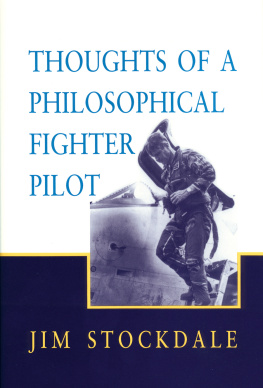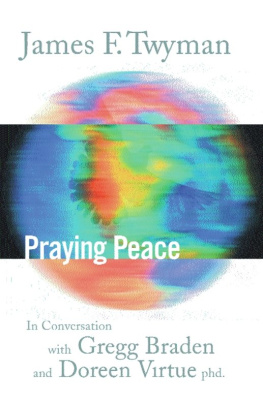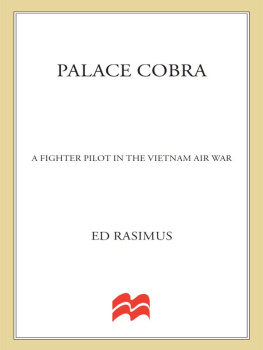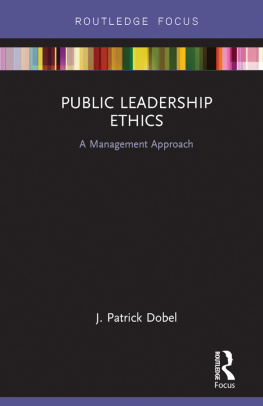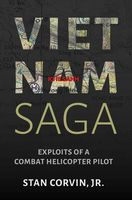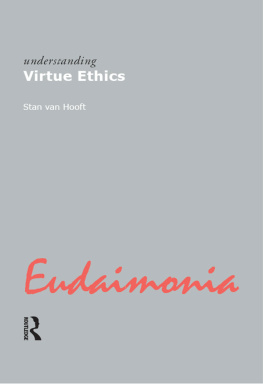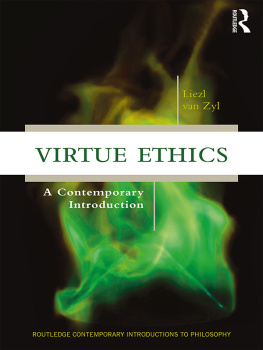THOUGHTS OF A
PHILOSOPHICAL
FIGHTER PILOT
THOUGHTS OF A
PHILOSOPHICAL
FIGHTER PILOT
James Bond Stockdale
HOOVER INSTITUTION PRESS
Stanford University
Stanford, California
The Hoover Institution on War, Revolution and Peace, foundedat Stanford University in 1919 by President Herbert Hoover,is an interdisciplinary research center for advanced study ondomestic and international affairs in the twentieth century.The views expressed in its publications are entirely those ofthe authors and do not necessarily reflect the views of the staff,officers, or Board of Overseers of the Hoover Institution.
www.hoover.org
Hoover Institution Press Publication No. 431
Copyright 1995 by the Board of Trustees of the Leland Stanford Junior University
All rights reserved. No part of this publication may be reproduced,stored in a retrieval system, or transmitted in any form or by anymeans, electronic, mechanical, photocopying, recording, or otherwise,without written permission of the publisher.
First printing, 1995
First paperback printing, 1995
14 13 12 11 14 13 12 11 10 9
Manufactured in the United States of America
The paper used in this publication meets the minimum requirementsof American National Standard for Information SciencesPermanenceof Paper for Printed Library Materials, ANSI Z39.48-1984.
Library of Congress Cataloging-in-Publication DataStockdale, James B.
Thoughts of a philosophical fighter pilot I James Bond Stockdale.p. cm. - (Hoover Institution Press publication; no. 431)
ISBN-10: 0-8179-9391-6 (cloth : alk. paper).
ISBN-13: 978-0-8179-9391-7 (cloth : alk. paper)
ISBN-10: 0-8179-9392-4 (pbk. : alk. paper)
ISBN-13: 978-0-8179-9392-4 (pbk.: alk. paper)
1. Vietnamese Conflict, 1961-1975-Personal narratives, American.
2. Stockdale, James B. 3. Air pilots. Military-United StatesBiography.
4. United States. Navy-Biography. I. Title.
DS559.5.S76 1995
959. 704 38-dc20 95-20171
CIP
ABOUT THE AUTHOR
VICE ADMIRAL JAMES BOND STOCKDALE was a true American hero. Shot down on September 9, 1965, during a mission over North Vietnam, hespent seven and a half years as a prisoner of war. Despite enduring relentlesstorture, intimidation, and four years of solitary confinement, he refusedto capitulate, even earning the grudging respect of his captors. He ultimatelyreceived 26 combat decorations, including two Distinguished FlyingCrosses, three Distinguished Service Medals, four Silver Star Medals, twoPurple Hearts, and the Congressional Medal of Honor, the nations highestaward for valor. He had the distinction of being the only three-star officerin the history of the navy to wear both aviator wings and the Medal ofHonor.
Stockdale retired from the military in 1979 to become president of theCitadel, a widely renowned military college in South Carolina. On his retirement,the navy established the Vice Admiral James Bond StockdaleLeadership Award, which is presented annually to two commanding officers,one in the Atlantic Fleet and one in the Pacific Fleet.
He left the Citadel in 1981 to become a senior research fellow at theHoover Institution at Stanford University. In addition to this book, he isthe author of two other works published by Hoover Institution: Courage under Fire: Testing Epictetuss Doctrines in a Laboratory of Human Behavior (Hoover Essays, No. 6, 1993) and A Vietnam Experience: Ten Years of Reflection (1984). Stockdale and his wife, Sybil, were coauthors of In Love and War (Harper & Row, 1984), which in 1987 was made into an NBC television movie viewed by more than 45 million Americans.
In 1992 Admiral Stockdale was an independent candidate for vice presidentof the United States as Ross Perots running mate. He said he ran torepay his debt to Perot, who had worked to help free POWs in Vietnam.In 1993 Stockdale became the first naval aviator of the Vietnam era tobe inducted into the Carrier Aviation Hall of Fame. He was later the subjectof Stockdale Triumphs: A Return to Vietnam, a documentary about hisfirst trip back to Vietnam in 1994. Produced by Catherine OBrien of theStanford Video Media Group, the film received a Telly Award in the history/biography category. In the 45-minute video, he returns to Hanoi andthe Hoa Lo prisonthe Hanoi Hiltonwhere he was held for most ofhis imprisonment, discussing his prisoner of war experience and exploringthe changed city.
James B. Stockdale died at his home in Coronado, California, in 2005at the age of 81. At the time of his death he held eleven honorary doctoraldegrees. His home, where he lived since 1963, has been designated a citylandmark.
TRIALS BY FIRE
THE MELTING EXPERIENCE:
GROW OR DIE
Speech delivered to the graduating class of 1981 at
John Carroll University in Cleveland, Ohio.
YOUR PRESIDENT [FATHER OMALLEY] and I have a mutual friend, a Bostonthoracic surgeon who has a great sensitivity for issues concerning the meaningof life and the nature of man. Its easy to understand how a man whospends the best part of his busy days at the pressure-packed juncture of lifeand death could become absorbed in philosophical thought. But this doctordoesnt let it go at that. He refines his thoughts through reading and sharesthe best of his high-quality professional articles, those bearing on the humanpredicament in general and human ethics in particular, with Father OMalleyand me and a few others. Well, all this bears on how Im going to spend thenext fifteen minutes because it follows that any of us in the Dr. EugeneLaforet network could expect our colleagues to have some pretty strongnotions about ethical systems and their formulation. Ive been asked toexpose some of mine today.
Pressurized experiences have a way of giving us an overload of dilemmasthat cant wait for a waffled solution. We seem to be continually in theposition, described by Dr. Alfred North Whitehead, of not being able tobring half an umbrella to work just because the weatherman says theres a50 percent chance of rain. When Dr. Laforet gets a persons chest openedup, he has to cut here or cut there in a finite interval of time. He cant waffle.Students at John Carroll University have to take the scheduled exams andpass or flunk, ready or not. Life seems to become compressed, running ahead,as if being watched on a movie screen, with the projector set on high-speedadvance.
But in these circumstances, as your attention is channeled, as you concentrate,you can sometimes sense that youre undergoing a melting experience.Some of your inhibitions and preset feelings, fears, and biases meltas you come to realize that, under the gun, you must grow or failin somecases, grow or die. A sort of transformation takes place under pressure underwhat the alchemists of the Middle Ages called the hermetic.
The hermetic idea is old, having come down from ancient Egypt andGreece and been colored by Christian sacramental teaching. It was a two-foldconcept. It meant something sealed offhermetically sealed, as we say. And it also meant magic, particularly magical transformation. You put somethingin a crucible or a retort and you subjected it to certain pressures like heat ordoses of sulphur or mercury. If you were lucky or wise or both, some kindof creative transformation would take place. In physical terms, this referredto the changing of base metals into precious oneslead into gold.
But the top-grade alchemical philosophers were not content with merephysical crucibles and crystal retorts they could hold in their hands. Theywere aiming at even more important things. Paracelsus thought it might bepossible to create a human being (homunculus) in the laboratorysomethingpeople today are again getting uneasy about. The higher alchemyaimed not at mere physical change but at moral and spiritual transformation.The crucible and retort became symbols of creative growth. Fire and thetwin elements sulfur and mercury came to represent the outside pressuresexerted upon the human soul in its confined place. In extreme cases, the firemight be of hellish origin. But if the soul in question were strong enough,not mere passive matter, that spirit might undergo an alchemical changeametamorphosis of the spirit in which the ordinary stuff of humanity couldturn into something precious, emerging as if from a tightly sealed cocoon.

